(RichardDetrich) Indigenous groups that were in Panama when Columbus arrived . . .
One of the remarkable things about this tiny, squiggly, isthmus of land joining together North and South America, is that there are SEVEN . . . that’s right seven! . . . Indigenous groups of people who were here before the Europeans arrived. It’s estimated that there may have been a million Indigenous in Panama when Columbus first arrived in 1502.
In most countries of Middle America the arrival of white Europeans produced tragic consequences. Arriving explorers and exploiters brought with them fire arms, previously unknown animals like horses and attack dogs, and diseases to which the Indigenous had no immunity.
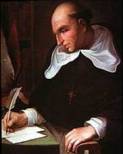 Additionally many of the Spanish conquistadors enslaved Indigenous people to use as workers and were very cruel to the populations they conquered. Bartolome de las Casas [photo at left] came to the Americas as a Spanish conquistador. Later he repented and became a monk. Alarmed by Spanish actions toward the Indigenous across the Americas, in 1552 Friar Bartolome de las Casas sent a letter to Phillip II of Spain entitled “A Short Account of the Destruction of the Indies” in which he depicted the cruelty and sadism of the Spanish toward the Indigenous.
Additionally many of the Spanish conquistadors enslaved Indigenous people to use as workers and were very cruel to the populations they conquered. Bartolome de las Casas [photo at left] came to the Americas as a Spanish conquistador. Later he repented and became a monk. Alarmed by Spanish actions toward the Indigenous across the Americas, in 1552 Friar Bartolome de las Casas sent a letter to Phillip II of Spain entitled “A Short Account of the Destruction of the Indies” in which he depicted the cruelty and sadism of the Spanish toward the Indigenous.
Vasco Nunez de Balboa, who founded the first settlement in the Americas at Darien, Panama in 1511, was known for his cruelty towards Indians [Indigenous in Panama aren’t hung up on “political correctness” and 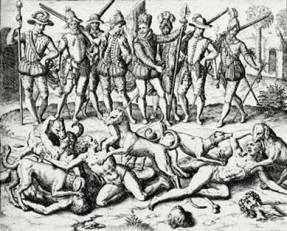 either “Indigenous” or “Indian” is acceptable] as he expanded his territory and searched for gold. Somewhat contemporaneous is this woodcut by Theodore De Bry (1528-1598) entitled, “Balboa setting his dogs upon Indian practitioners of male love whom he ordered eaten alive by the war dogs”.
either “Indigenous” or “Indian” is acceptable] as he expanded his territory and searched for gold. Somewhat contemporaneous is this woodcut by Theodore De Bry (1528-1598) entitled, “Balboa setting his dogs upon Indian practitioners of male love whom he ordered eaten alive by the war dogs”.
The Spanish exploration resulted in what has been called “the greatest known population loss in human history – that is mortality as a percentage of population.” For example, it is believed that the population of central Mexico may have fallen by almost 90% in 75 years.
So it is truly remarkable that in Panama you have seven living indigenous cultures that were here before European explorers arrived! The remaining groups are . . .
- Kunas
- Gnobe
- Bugle
- Embera
- Wounan
- Teribes
- Bokotas
The groups most likely to be encountered by visitors to Panama are the Kuna, Embera/Wounan and Gnobe Bugle.
Kunas, or Cunas . . . “Tule” in their own language, meaning simply, “The People”
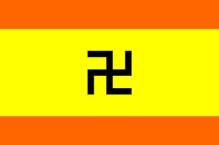 The Kuna people largely inhabit the San Blas Islands, 365 islands off the north coast of the Isthmus of Panama, east of the Canal. This is part of the “comarca” of Kuna Yala. The Kuna are one of the most powerful Indigenous groups in Panama and have actually gone to war with the Republic of Panama over disagreements. Few cruise guests are fortunate enough to visit the San Blas Islands anymore because the powerful Kuna elders and Kuna General Congress, not wanting to become another Nassau or St. Thomas, drastically limit the number of cruise ships calling in Kuna Yala.
The Kuna people largely inhabit the San Blas Islands, 365 islands off the north coast of the Isthmus of Panama, east of the Canal. This is part of the “comarca” of Kuna Yala. The Kuna are one of the most powerful Indigenous groups in Panama and have actually gone to war with the Republic of Panama over disagreements. Few cruise guests are fortunate enough to visit the San Blas Islands anymore because the powerful Kuna elders and Kuna General Congress, not wanting to become another Nassau or St. Thomas, drastically limit the number of cruise ships calling in Kuna Yala.
The flag of Kuna Yalawas adopted in 1925, long before the Nazi episode.
It is estimated that there are some 50,000 to 60,000 Kuna in Panama. Largely island, shore people who live  in homes made of thatched roofs and canes. They speak their own Kuna language, as well as Spanish, and traditionally travel by dug out boats or “pangas”. They are a monogamous people with traditionally arranged marriages with a formal marriage ceremony. They are agricultural people who fish and hunt and are very dependant on the ocean as a food source so fishing is a daily task. Traditional baskets are made by the men, and the women make colorful traditional molas which are often for sale in Panama City. You will frequently see Kuna people in Panama City and the women stand out with their traditional dress and beaded forearms and legs.
in homes made of thatched roofs and canes. They speak their own Kuna language, as well as Spanish, and traditionally travel by dug out boats or “pangas”. They are a monogamous people with traditionally arranged marriages with a formal marriage ceremony. They are agricultural people who fish and hunt and are very dependant on the ocean as a food source so fishing is a daily task. Traditional baskets are made by the men, and the women make colorful traditional molas which are often for sale in Panama City. You will frequently see Kuna people in Panama City and the women stand out with their traditional dress and beaded forearms and legs.
The fabric for the molas is ripped, not cut with sissors, and then hand sewn into intricate patterns. You will see molas on sale throughout Panama . . . sometimes aboard the ships, at the craft markets at Old Panama and the YMCA in Balboa, and on the dock at Christobal, Colon. Price range from $10 to thousands of dollars for museum quality molas. Like any craft item, the complexity and quality of the work is a major factor in determining price.
Gnobe Bugle
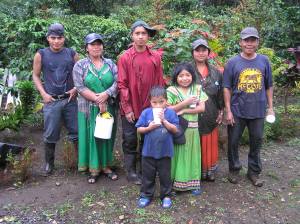 The Gnobe Bugle are the largest Indigenous group in Panama and the only group that was never intimidated or conquered by the Spanish. These people are lumped together as Gnobe Bugle but really have two distinct languages, Gnobe and Bugle. They were known as Guaymies by Europeans and Americans but do not like that name, preferring their self-given name Gnobe Bugle.
The Gnobe Bugle are the largest Indigenous group in Panama and the only group that was never intimidated or conquered by the Spanish. These people are lumped together as Gnobe Bugle but really have two distinct languages, Gnobe and Bugle. They were known as Guaymies by Europeans and Americans but do not like that name, preferring their self-given name Gnobe Bugle.
These folks live mostly in the Chiriqui highlands and are the folks who live around us in Palmira. The photo to the left is of our Gnobe Bugle neighbors who helped us pick our coffee. The women wear brightly colored dresses with intricate trim patterns which they sew themselves and the men . . . well, the men wear whatever clothes they buy at places like Ropa Americana, the end-of-the-line for clothes that don’t sell in the US. Just because the guy picking your coffee has a shirt that says “Harvard” doesn’t mean he went there!
These are agricultural people, subsistence farmers raising rice, corn, yucca, otoy, ñame, beans, chickens, pigs and cattle. To obtain money they will work the coffee harvest and on cattle farms and banana plantations. Now, in and around Boquete because of the construction boom, you will also see some Gnobe Bugle working at entry level construction jobs.
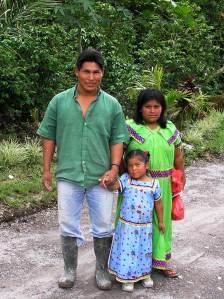 These folks travel amazing distances by walking, or use independent cabs or local buses around developed areas. They are polygamous and have what appears to gringo eyes to be a very loose family structure. They were empowered by Panamanian strongman General Omar Torrijos and have a “comarca” that is larger than many Panamanian states.
These folks travel amazing distances by walking, or use independent cabs or local buses around developed areas. They are polygamous and have what appears to gringo eyes to be a very loose family structure. They were empowered by Panamanian strongman General Omar Torrijos and have a “comarca” that is larger than many Panamanian states.
Indigenous people are generally regarded as “second class” within Panamanian society, except at election time when their votes are generally, and unofficially purchased with much needed cash. The Gnobe Bugle are by far the largest Indigenous group with somewhere between 200,000-280,000. Census numbers for Indigineous are notoriously inaccurate.
Despite national efforts to provide some community health care, the Gnobe Bugle have a high infant mortality rate. Women are very subservient, often not allowed by their men to learn Spanish and often the subject of payday liquour induced fights between men, with the “winner” taking the woman. There are some efforts to educate and empower Gnobe Bugle women.
Embera/Wounan
 The Embera and Wounanare people of the same genetic stock, although they have developed two distinct languages. They live over a wide area from Panama, into Columbia and even into Ecuador. Because they are a jungle people, who live in small communities, sometimes deep in the jungle, it is hard to get an accurate count of the numbers in Panama, since many live up into the otherwise impenetrable Darien jungle.
The Embera and Wounanare people of the same genetic stock, although they have developed two distinct languages. They live over a wide area from Panama, into Columbia and even into Ecuador. Because they are a jungle people, who live in small communities, sometimes deep in the jungle, it is hard to get an accurate count of the numbers in Panama, since many live up into the otherwise impenetrable Darien jungle.
Because several groups of these people have lived in the area which is now the Chagres National Park and are within a couple of hours of Panama city, via car or bus and dug out canoe, they are often visited by tour groups from hotels and cruise ships.
They are an agricultural people who traditionally subsisted by growing their own crops, fishing, and hunting. They travel by foot and canoes or piraguas dug out from large tree trunks. They are a monogamous people, traditionally with arranged marriages, although that is changing. There are estimated to be between 35,000 to 80,000 Embera living within Panama.
Rarely will you see these folks in Panama City since they know they will only end up with low-end jobs. There is a big commitment to the extended family, the village, and preserving traditional Embera culture.
In Central Panama you will find Embera and Wounan villages which have more “adapted” to local agricultural traditions and dress. Sometimes you will find Embera/Wounan villages in which three languages are spoken: Embera, Wounan and Spanish.
 During the Canal Zone days they were called Chocoes and we very much looked down on, because of their traditional lifestyles and dress. People who grew up in the Canal Zone, Zonians, have told me that when they were children they were told never to leave the Canal Zone because there were cannibals out there who would eat them! Indians are second class citizens in Panama. Most Panamanians have never visited or even thought of visiting an Embera Indian village. Interestingly, as the tourist value of the Embera is being discovered, and their images appear on tourist flyers and posters, suddenly ordinary Panamanians are starting to appreciate the value of these Indigenous groups and the value of preserving their cultures.
During the Canal Zone days they were called Chocoes and we very much looked down on, because of their traditional lifestyles and dress. People who grew up in the Canal Zone, Zonians, have told me that when they were children they were told never to leave the Canal Zone because there were cannibals out there who would eat them! Indians are second class citizens in Panama. Most Panamanians have never visited or even thought of visiting an Embera Indian village. Interestingly, as the tourist value of the Embera is being discovered, and their images appear on tourist flyers and posters, suddenly ordinary Panamanians are starting to appreciate the value of these Indigenous groups and the value of preserving their cultures.
Teribes
This is the smallest Indigenous group, numbering about 3,000, and living on the banks of the Teribe River in Bocas del Torro. They are subsistence farmers, hunters and fishermen. They make baskets and utensils out of wood. Because their homes are located near the river they sit on strong poles and hills to protect them from flooding. They dress in western style clothing and travel by dug out canoe. Their government is a monarchy or reigning family.
Bokotas
This is a small group, generally thought to be under 5000, living around Bocas del Toro and Veragua. They are largely agricultural people growing crops and domestic animals for their own consumption. They travel mostly by dug out canoes and like most Panamanian Indigenous groups living in houses made of palm, bamboo and cane. They use dogs for hunting. They usually are aligned politically with the larger Gnobe Bugle and are a monogamous people.